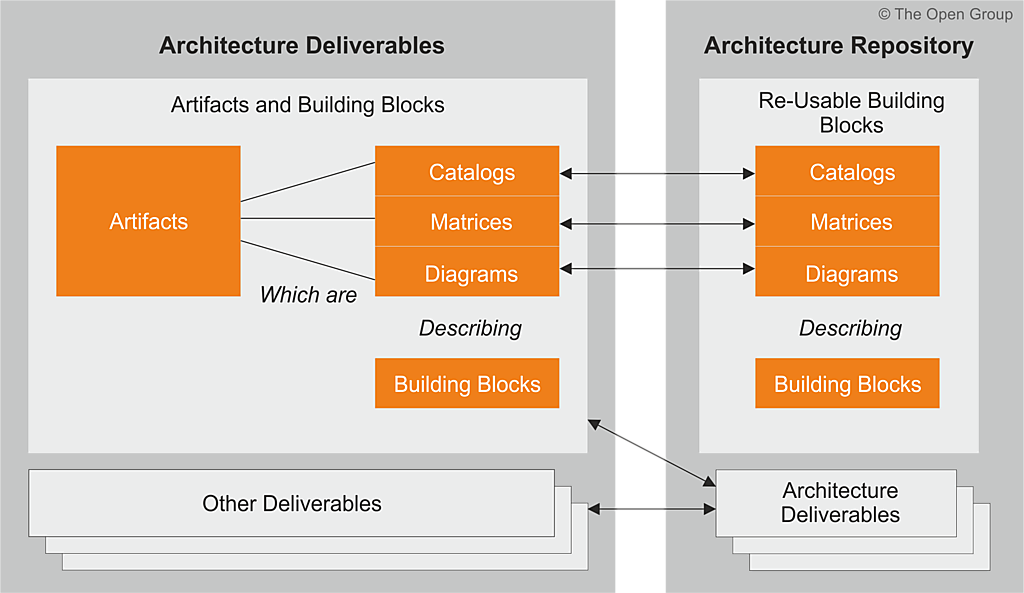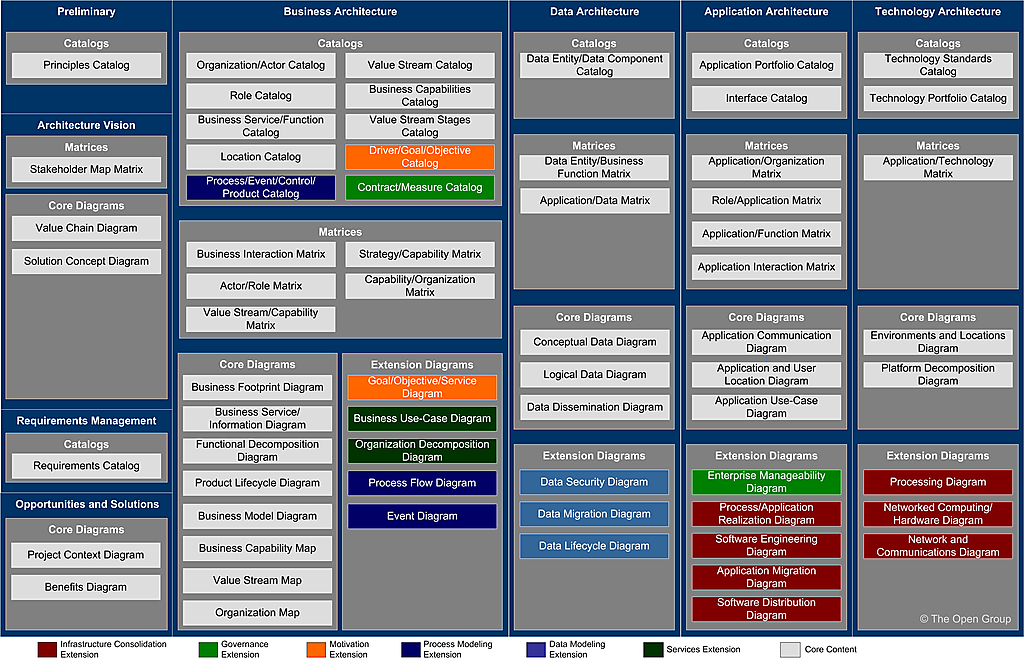Introduction
In the intricate world of enterprise architecture, the TOGAF® (The Open Group Architecture Framework) Architecture Development Method (ADM) stands tall as a comprehensive framework for crafting and overseeing enterprise architectures. At the heart of TOGAF ADM lies the creation and application of architectural artifacts—a key component that facilitates the organization, communication, and comprehension of architectural information. This tutorial dives into the diverse array of architectural artifacts within TOGAF ADM, shedding light on their significance and elucidating which artifacts align with each phase of the ADM.
The Role of Architectural Artifacts
Architectural artifacts serve as vital threads woven into the fabric of TOGAF ADM, aiding in the structuring and transmission of architectural information to stakeholders. They serve as a conduit, bridging the technical intricacies of architecture development with the specific concerns of stakeholders. The primary types of architectural artifacts in TOGAF encompass building blocks, catalogs, matrices, and diagrams.

- Building Blocks Fundamental entities in the architecture metamodel, building blocks can represent core elements such as a business service like “Purchase Order.” Laden with metadata, including attributes like owner, building blocks become invaluable for querying and analysis. Their versatility allows them to encapsulate various facets of architecture.
- Catalogs Catalogs, akin to well-organized lists of building blocks, serve governance and reference functions. An example is an organizational chart displaying locations and actors within a structure. Like building blocks, catalogs come equipped with metadata, enhancing their utility for stakeholders seeking specific information.
- Matrices Represented as grid-based configurations, matrices visually articulate relationships between multiple model entities. They excel in illustrating list-based relationships that may not be easily depicted graphically. For instance, a CRUD matrix can unveil applications performing specific data operations, providing a structured means for analyzing intricate relationships within the architecture.
- Diagrams Graphical renditions of architectural content, diagrams are crafted to facilitate efficient retrieval of information by stakeholders. These visual aids serve the dual purpose of representing architecture content and ensuring completeness in the collected information. TOGAF prescribes a set of architecture diagrams, such as organization charts, customizable to cater to diverse stakeholder concerns.
Mapping Architectural Artifacts to ADM Phases
The supplied diagram serves as a guide, delineating Architectural Artifacts aligned with their respective phases within the TOGAF ADM framework. Additionally, the accompanying figure highlights the recommended artifacts to be generated in each ADM phase.
Let’s delve deeper into the mapping of Architectural Artifacts to ADM Phases:

- Mapping Architectural Artifacts to ADM Phases
The strategic alignment of Architectural Artifacts with the distinct phases of the TOGAF ADM framework is akin to orchestrating a symphony where each note resonates in harmony with the progression of the architectural journey. This meticulous mapping not only streamlines the development process but also acts as a compass, guiding architects through the complex landscape of enterprise architecture. Let’s unfurl the intricate connection between these artifacts and the evolutionary cadence of ADM phases:
- Preliminary Phase: As the curtain rises on the Preliminary Phase, the focus is on setting the stage for the architectural endeavor. Here, foundational artifacts like high-level vision statements and principles come to the forefront. Preliminary Architecture Vision Diagrams provide a visual sketch of the envisioned architecture, setting the tone for subsequent phases.
- Phase A – Architecture Vision: In the embryonic stages of architecture formulation, building blocks take center stage. These building blocks, such as conceptual data models and business service catalogs, lay the groundwork for the Architecture Vision. Matrices play a supporting role, elucidating relationships between these nascent entities.
- Phase B – Business Architecture: As the architectural narrative unfolds into the Business Architecture phase, catalogs become crucial navigational aids. Business Service Catalogs, alongside organization catalogs, become instrumental in structuring and classifying business components. Diagrams, like organization charts, visually articulate the intricate interplay of these components.
- Phase C – Information Systems Architectures: Matrices step into the spotlight in Phase C, weaving a web of relationships between data entities and applications. Data Entity-Business Function Matrices, for instance, lay bare the dependencies and interactions between business functions and the corresponding data entities. These matrices serve as invaluable tools for unraveling the complexity inherent in information systems architectures.
- Phase D – Technology Architecture: The technological tapestry unfolds in Phase D, where building blocks extend their influence to encompass technology components. Technology Standards Catalogs and Technology Portfolio Catalogs emerge as indispensable artifacts, providing a structured view of the technological landscape. Diagrams, such as platform decomposition diagrams, visually dissect the layers of technology components.
- Phase E – Opportunities and Solutions: Building on the foundation laid in previous phases, Phase E sees the orchestration of opportunity and solution-based artifacts. Solution Building Blocks, encapsulating refined solutions to architectural challenges, take center stage. Implementation and Migration Plans, presented as matrices, outline the tactical steps to bring these solutions to fruition.
- Phase F – Migration Planning: Matrices continue to play a pivotal role in Phase F, as the focus shifts to migration planning. Transition Matrices become indispensable, charting the course of evolution for each building block. These matrices provide a structured framework for orchestrating the transition from the current state to the envisioned future state.
- Phase G – Implementation Governance: Governance takes the limelight in Phase G, with catalogs such as Architecture Contracts and Compliance Matrices. These artifacts provide the governance framework necessary for overseeing the implementation process. Diagrams, like transition state diagrams, visually articulate the checkpoints and milestones in the implementation journey.
- Phase H – Architecture Change Management: The evolution of architecture is an iterative process, and in Phase H, change management artifacts come into play. Requirements Impact Matrices showcase the impact of change on existing requirements, facilitating a nuanced understanding of the implications. These matrices serve as essential tools for managing the dynamic nature of architectural evolution.
- Requirements Management: Closing the symphony in the Requirements Management phase, building blocks and catalogs continue to influence the refinement of requirements. Requirement catalogs, enriched with metadata, provide a comprehensive view of the evolving requirements landscape. Matrices, such as Traceability Matrices, weave a thread of traceability, connecting requirements to the underlying architectural elements.
In essence, the strategic orchestration of Architectural Artifacts across ADM phases is the linchpin that transforms the complex dance of architectural development into a coherent and purposeful journey. Each artifact, meticulously placed in its phase, contributes to the unfolding narrative of enterprise architecture, ensuring a seamless progression towards the realization of business goals and stakeholder aspirations.
Conclusion
In the realm of TOGAF ADM, architectural artifacts emerge as linchpins, facilitating architects in communicating, organizing, and analyzing architectural information with precision. A nuanced understanding of the artifacts associated with each ADM phase simplifies the architecture development process and enriches communication with stakeholders. By adeptly employing the right artifacts at the right junctures, architects ensure that their architecture projects harmonize with business objectives and stakeholder requisites, paving the way for triumphant enterprise architecture outcomes.